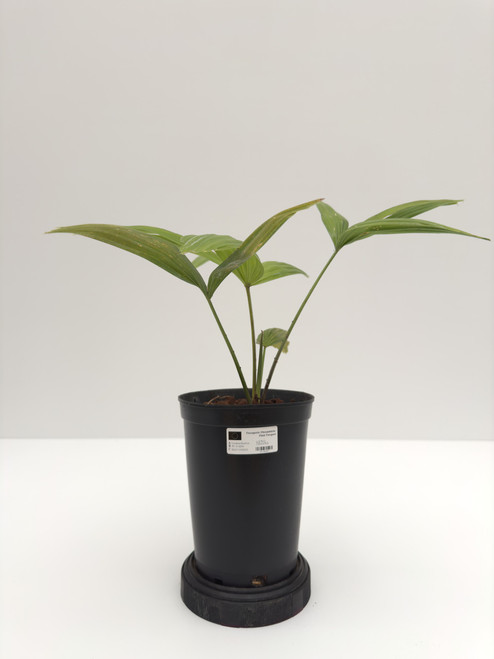Product Description
Habitat and Distribution
Papua New Guinea. In West Sepik Prov., Oenake Mts. Rainforest on ridges, limestone and metamorphic rocks, at 400-600 m alt. Flowers Nov-Jan; fruits Feb-Mar.
Description
Hermaphroditic palm. Trunk to 20 m tall, 15-20 cm dbh, leaf scars slightly raised, narrow, dark grey, internodes broad, grey. Leaves 24-40 in a globose crown; petiole 150-200 cm long, proximally ca 10 cm wide, distally ca 1.5 cm wide, adaxially flat, arching, glabrous, green, margins with single, recurved, green spines 1-2 mm long throughout its length, but larger and more closely spaced in the proximal portion, margins lacerate fibrous in extreme basal portion; leaf-base fibres prominent, in 2 layers of more or less equal coarseness, persistent in sheets, chestnut brown; appendage to 60 cm long; hastula raised, small, semi-circular; lamina costapalmate, regularly segmented, subcircular, 150-200 cm long, 120- 150 cm wide, adaxially bluish-green, abaxially silvery glaucous; lamina divided for 62-85% of its length, with 60-75 segments, depth of apical cleft 1-3% of the segment length, apical lobes rigid, but becoming pendulous with age or damage, segment 3-4 cm wide where the segments diverge; parallel veins 6-7 each side of midrib; transverse veins thinner than parallel veins. Inflorescences trifurcate with ± similar collateral axes, branched to 3 orders, each axis ca 200 cm long, not extending beyond the limit of the crown, with 5-6 partial inflorescences; prophyll to 30 cm long, 10.5 cm wide, yellow, coriaceous basally, brown chartaceous distally, glabrous apart from ferruginous woolly tomentum along the carinae; peduncle with one tubular, papery and loosely sheathing peduncular bract, densely scaled at the apex otherwise glabrous; peduncle of individual axes basally subterete, becoming dorsi-ventrally compressed distally, edges angular, furfuraceous in parts enclosed in bracts, otherwise patchily furfuraceous or glabrous on exposed surfaces; rachis bracts tubular, papery, loosely sheathing, glabrous apart from some irregular pubescence toward the apex, apices more or less nonfibrous showing only minor disintegration; rachillae 6-12 cm long, to 3 mm diam., straight, green-red, glabrous. Flowers solitary; sepals basally fused, red, with lobes to 1-1.2 mm long; petals broadly triangular, ca 2 mm long, basally connate for ca half their length, thick, fleshy, red, apical margins recurved, outer surface minutely warty; stamens much shorter than petals, basal part fused to petal, shoulders flat; filament very short; anthers 0.2 mm long, cream. Fruit globose with a basal constriction, 35- 43 mm diam., semi-glossy orange-red, stigmatic remains apical; epicarp with scattered lenticellular dots, glossy, longitudinal stripe of suberised epidermal tissue usually visible for the full length of the fruit; mesocarp 13-15 mm thick, softly fibrous, mealy, orange; endocarp to 2 mm thick, bony; pedicel 2.5-5 mm high, ca 2 mm wide. Seed globose, 22-28 mm in diam., endosperm deeply intruded by orange pulpy tissue; embryo lateral. Eophyll not seen. Editing by edric.
The first recognition of Livistona tothur in the literature was an informal note by Essig & Young (1981) who described a palm seen from their helicopter as "a large Livistona bearing red fruit". Upon landing nearby, they were only able to find juveniles that they photographed, and which closely resembled those that are now known in populations of L. tothur. Subsequently, field work in New Guinea was undertaken by Ferrero (1997) who investigated reports of palm populations throughout Papua New Guinea and was to eventually collect and record the populations of this species in the Oenake Mountains of West Sepik Prov. Further field work undertaken by Barfod and Damborg resulted in collections, including the type, Damborg 418, upon which this taxon was described. The species name was taken from the vernacular, tot-hur, used in the Bewani area, West Sepik Prov., Papua New Guinea. Livistona tothur is a moderate canopy palm to 20 m tall; leaves are moderate and regularly segmented; segment apices are rigid, and with a bifurcate cleft 1-3% of the segment length; the inflorescence is basally trifurcate, not extending beyond the limit of the crown, and with up to 6 partial inflorescences; bracts are loosely sheathing; flowers (sepals, petals and carpels) are red; fruit are globose, to 25 mm diam., and shiny orangered at maturity.
Culture
Cold Hardiness Zone: 10b
Comments and Curiosities
Uses: Roofs and umbrellas are made from the leaves, bows from the split trunk, and salt is obtained from the ash of burned petioles.
Conservation: Near threatened.











